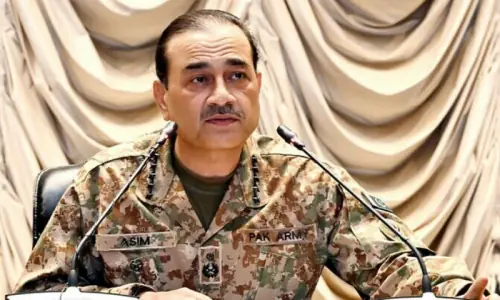• UN monitoring report says banned outfit enjoys backing of Taliban regime, support from Al Qaeda
• Backs Islamabad’s assertions Afghans being used to launch attacks in Pakistan, Nato weaponry in TTP
hands
• Voices concern over IS-K elements being ‘strategically’ pushed into Pakistan, Iran and Central Asia
KARACHI: The proscribed Tehreek-i-Taliban Pakistan (TTP) is now the largest terrorist group in Afghanistan, enjoying operational and logistical support from both the Afghan Taliban and factions of the Al Qaeda terrorist network, according to a United Nations monitoring report.
“The Taliban do not conceive of TTP as a terrorist group: the bonds are close, and the debt owed to TTP significant,” states the 15th report of the ISIL (Daesh) and Al-Qaeda/Taliban Monitoring Team, submitted to the UN Security Council.
Estimating its strength at around 6,000-6,500 fighters, the report notes that TTP is now the largest among the two dozen or so such groups that enjoy freedom to manoeuvre, under the oversight of the Taliban regime.
This lends credence to Islamabad’s stance that Kabul is unwilling to act against Pakistan-facing terrorist groups, something officials such as Defence Minister Khawaja Asif and Interior Minister Mohsin Naqvi have reiterated time and again.
The report notes that TTP “continues to operate at significant scale in Afghanistan and to conduct terrorist operations into Pakistan from there, often utilising Afghans”.
“TTP has intensified attacks against Pakistan, significantly increasing from 573 in 2021 to 715 in 2022 and 1,210 in 2023, with the trend continuing into 2024,” the report, updated until May 28, states.
This also lines up with Islamabad’s claims of the involvement of Afghan nationals in a number of recent terrorist attacks, such as the Bisham bombing, which claimed the lives of five Chinese engineers and their Pakistani driver. The report also mentions this particular incident.
It also backs Pakistan’s worry that Nato-calibre weapons, especially night vision capability, have been provided to TTP since the Taliban takeover, adding lethality to terrorist attacks against Pakistani border posts.
Al Qaeda support
The report also questioned the Afghan Taliban’s willingness to mitigate the TTP threat to Pakistan, given their historic ties, and describes the Taliban’s “ad hoc support to, and tolerance of, TTP operations”, which even includes the supply of weapons and permission for training and support from Al Qaeda in the Indian Subcontinent (AQIS).
“AQIS assists TTP in conducting terrorist attacks inside Pakistan, with Tehreek-i Jihad Pakistan (TJP) claiming responsibility so as to relieve pressure on the de facto [Afghan] authorities.”
Recalling the Sept 2023 clash between the Pakistani military and Afghan fighters — what the report termed the “largest TTP attack” of the past year — it said that when a large number of fighters launched a coordinated attack against two military posts in north-western Chitral, they were aided by a sizeable contingent from Al Qaeda.
Noting that Al Qaeda cells are operating in multiple Afghan provinces, mainly in the south-east, the report states most facilities associated with the group are mainly meant to train local fighters along with TTP operatives.
Al Qaeda’s support to TTP includes “sharing of Afghan fighters for its tashkils (in this context, military staffing or a formation) and training camps in Afghanistan. Training provided by AQIS has resulted in TTP shifting tactics and high profile attacks against hard targets”.
IS-K
IS-K, which has recently expanded its outreach to Russia, claiming a couple of daring attacks, features prominently in the UN report, which notes the Afghan Taliban’s success against this threat, also highlights glaring gaps.
IS-K and its affiliates in the region are estimated to have around 4,000 to 6,000 fighters, while others assess the core strength at 2,000-3,500. They have reportedly infiltrated the main ministries of interior, defence and intelligence while also seeking to covertly embed members in other groups such as TTP.
While acknowledging Kabul’s claim that its operations had pushed key IS-K personnel across its borders, the report voiced concern over the impact this displacement would have on the security situation in Pakistan, Iran and other Central Asian states.
In response to the “high attrition rates” of its fighters, the report notes how IS-K has limited its presence in Afghanistan and expanded its external operations, “with skilled operatives and suicide bombers encouraged to travel to Europe, the Russian Federation and other neighbouring countries.”
Describing their operations as “tactical rather than strategic”, the report notes that the Taliban’s counter-terrorism capabilities are deficient to meet the nature of that threat.
Published in Dawn, July 12th, 2024



































